Understanding the tread depth of a new tire helps you evaluate its condition and safety.
Most new tires come with a tread depth of 10/32" to 11/32", but those on SUVs or trucks could come with deeper grips.
Measuring the depth using a penny, the on-tire wear indicators, or a tire tread depth gauge gives you a rough idea of your new tires' longevity.
Below, we'll look at various tire tread depth measuring methods to help you determine whether it's time to replace your tires.
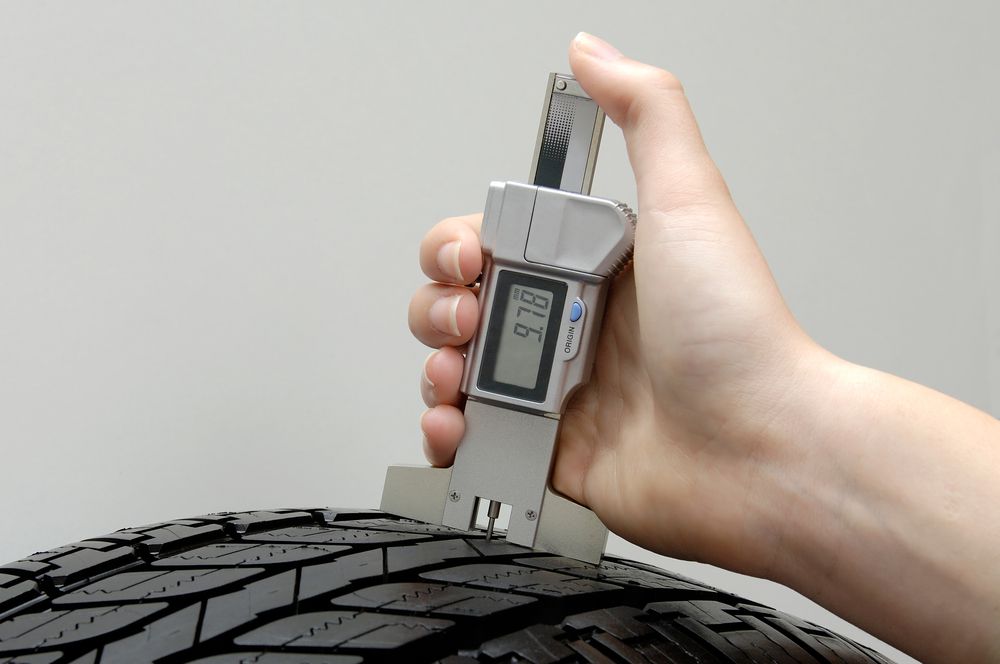 Taking the tread depth of a new tire.
Taking the tread depth of a new tire.
About Tire Tread Depth
In the USA, tire tread depth is measured in 32nds of an inch, and the United States Department of Transportation necessitates replacing them at 2/32".
Tire tread — the part that touches the road — must meet state requirements; otherwise, your car could lose traction and experience extended braking times, especially in wet climates.
Measuring your tire tread depth should play a major role in your regular vehicle maintenance routine to ensure you stay safe on the road.
How Many 32nds Tread on New Tires?
Normally, new passenger car tires come with a tire tread depth of 10/32" or 11/32".
However, trucks, SUVs, and winter tires can have deeper treads.
Something else to remember while you check tire tread depth is that there can be differences in tread depths between all-season tires, summer tires, and winter tires.
How Do I Know If My Tires are Good?
Use the penny test, a tire tread depth gauge, or consult the wear indicators to determine whether you have optimal tread depth.
You shouldn't let it fall below 2/32" (or 1.59 mm).
But tread depth is only part of the battle.
There are other checks to conduct to ensure your tires are fit for purpose, including:
- Sidewall cracks — Look for cuts or cuts in your tire's sidewall. If they're visible to the naked eye, your tire might be leaking or ready to blow out.
- Bulges and blisters protrude from the surface and considerably weaken your tire, causing sudden blowouts.
- Vibrations — While a small amount of vibration is natural, too much could indicate a problem. Misaligned or unbalanced tires typically cause it.
- Uneven Tread Wear - A tire's tread wears unevenly, so it's important to get your tires balanced regularly.
The above plus insufficient tire tread depth is a recipe for disaster that a mechanic can fix.
At What Tread Depth Should You Replace Your Tires?
As per U.S. law, you should replace your tires when the tread depth reaches 2/32" or below.
However, some argue that waiting until this point is already too dangerous as lower tread depths can hamper tire performance.
Thus, even though replacing your tires can be expensive, many drivers replace them when they hit 4/32".
Tire Tread Depth Chart
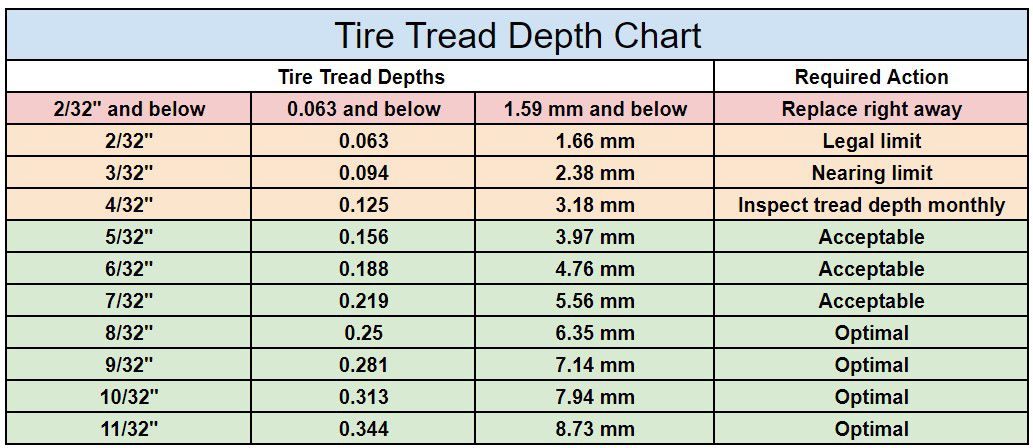 Tire tread depth chart
Tire tread depth chart
How to Measure Tread Depth with a Penny
Driving with worn tires is dangerous, so you should regularly inspect them for low tread depth.
The penny test aims to show whether your tire has hit the 2/32" threshold and thus, needs replacing.
Here's how to do it:
- Ensure your tire is at the proper tire pressure.
- Put a penny between the ribs — The rib is the raised part of the tread, spanning the tire's circumference.
- Turn the penny — Lincoln's head should point toward the tread.
- Evaluate the height — Is the top of Lincoln's head disappearing between the ribs? If so, your tread is above 2/32". If not, you should replace your tire as the tread isn't deep enough.
We suggest checking all tires and multiple points on each tire, paying attention to the most worn-looking zones.
If any part of the tire fails the penny test, you should replace it.
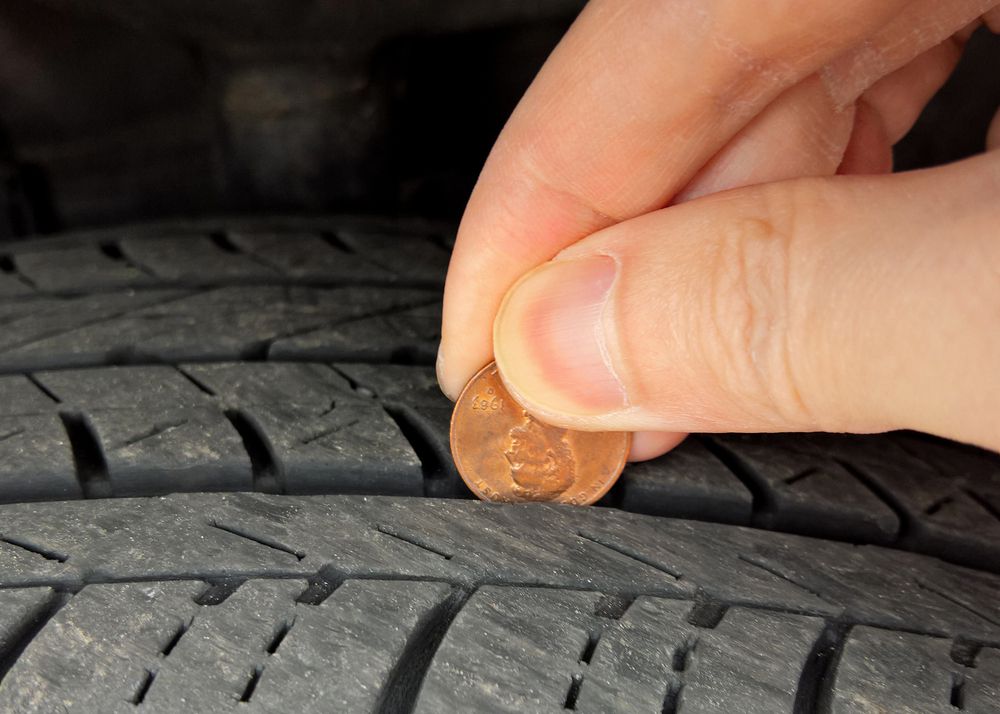 Performing penny test on a tire.
Performing penny test on a tire.
Is the Penny Test for Tires Accurate?
The penny test is accurate when following the 2/32" as the minimum tread depth.
However, some experts recommend following the 4/32" rule because waiting to hit the 2/32" mark may be too risky, especially in slippery conditions.
In this case, you should utilize another measuring method for improved accuracy.
How to Measure Tread Depth with Tread Wear Maintenance Indicators
Tread wear indicators are molded into the tread grooves at various intervals by the tire manufacturer.
While you should measure the tread depth accurately, paying attention to the on-tire indicators gives you a rough idea of their condition.
If the tire is flush with the indicator bars, its depth is below the legal limit.
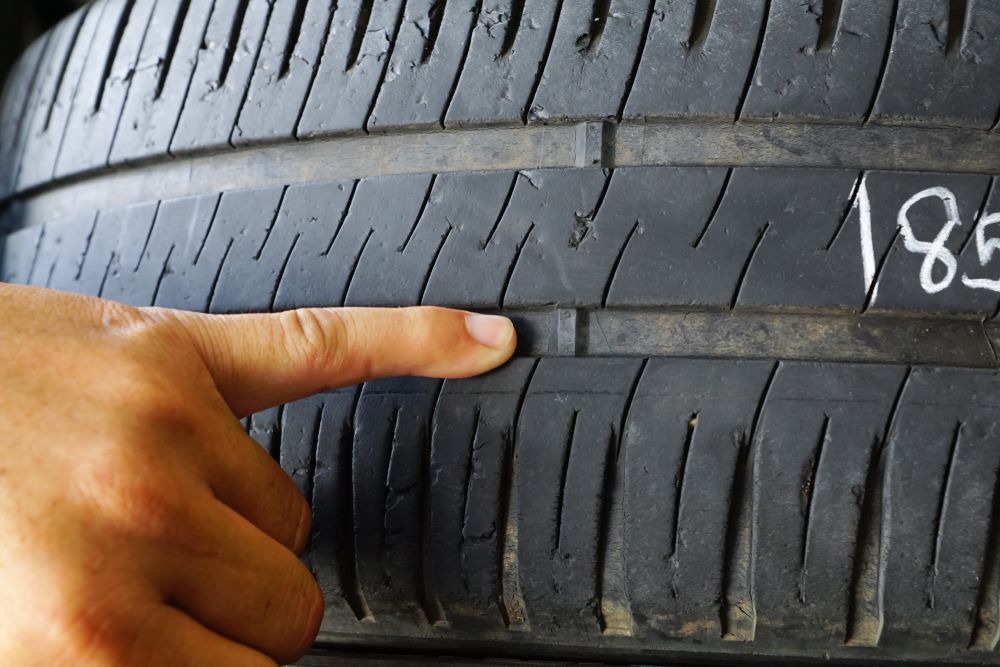 Tire tread wear indicators
Tire tread wear indicators
How to Measure Tread Depth with Tread Depth Gauge
Some tread depth gauges use 32nds of an inch scale, while others include millimeters.
Once you have identified the scale, follow the steps below to measure the tread depth:
- Push the gauge against the ground — Push the gauge against a hard, flat surface until it's fully compressed and you see the number "zero" on the scale.
- Insert the measuring scale — Push the measuring scale entirely into the gauge.
- Place the gauge into the groove — Put the probe into the middle of the tire's circumferential groove (i.e., rib) and apply pressure to the gauge's base. Ensure you don't place the probe on the molded tread wear indicators or other raised parts.
- Remove the gauge and confirm the reading — Hold the barrel and remove the gauge without touching the probe. Note the reading.
- Repeat process around the tire — Put the probe into additional spots on the tire roughly 15 inches apart to get an accurate picture of the overall condition.
- Average the readings — Calculate the per-tire average reading.
- Identify tire-wear percentage — Work out the percentage of wear by comparing the tire's original tread depth (find the figure in your car's specs) with your current findings.
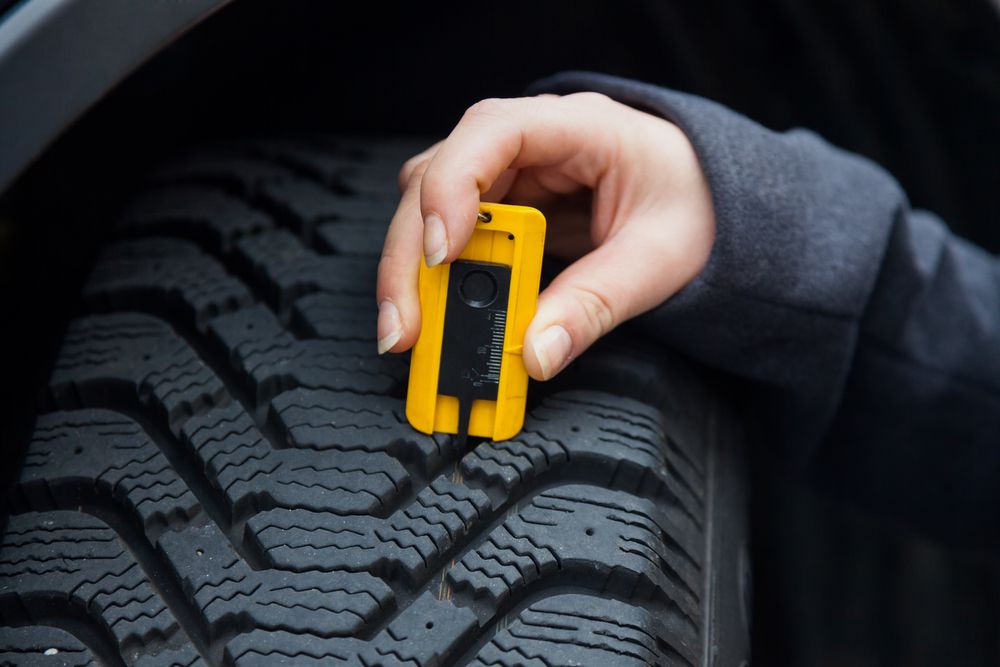 Tread depth gauge
Tread depth gauge
How Many Years Do Tires Last?
People typically drive between 12,000 and 15,000 miles every year.
So, a standard all-season tire tends to last between three and five years, depending on driving style, conditions, and maintenance.
But this isn't a hard-and-fast rule because the lifespan of your tires is mainly dependent on the number of miles you drive instead of their age.
Although, HeyCar recommends replacing all four tires every ten years, regardless of your driving habits and tread depth.
How Many Miles Do Tires Last?
These days, tires (those on a new vehicle) last around 50,000 miles.
However, some manufacturers build their tires to withstand a whopping 80,000 miles!
That said, you may need to replace them sooner if you notice any defects, often drive on unpaved roads or have a heavy gas pedal foot.
Note: Many tires (particularly factory models) show significant wear around the 20,000- to 30,000-mile mark.
Do Factory Tires Wear Out Faster?
Factory tires, otherwise known as OEM or Original Equipment Manufacturer tires, are made from soft rubber suitable for a diverse vehicle range.
Thus, they wear out quicker than standard models.
Remember, factory tires are made by the car's manufacturer, not a tire-dedicated company, so that you won't get that all-important long-distance wear.
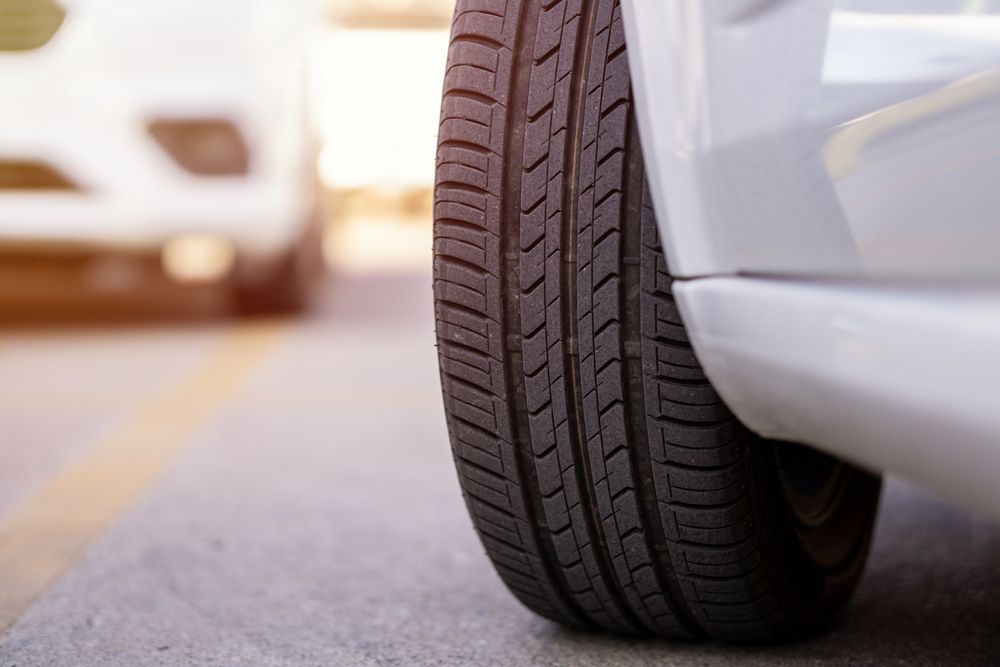 Brand new factory car tire.
Brand new factory car tire.
Why Do New Car Tires Wear Out So Fast?
New cars aren't equipped with high-quality tires.
Why?
Because manufacturers want the smoothest ride, they use super-soft rubber tires, which wear out twice as quickly.
When buying a new car, consider that you'll likely need to replace the tires reasonably soon, especially if:
- You drive a lot.
- You consistently drive on rough terrain.
- You're driving in adverse conditions.
- You want longevity and high performance.
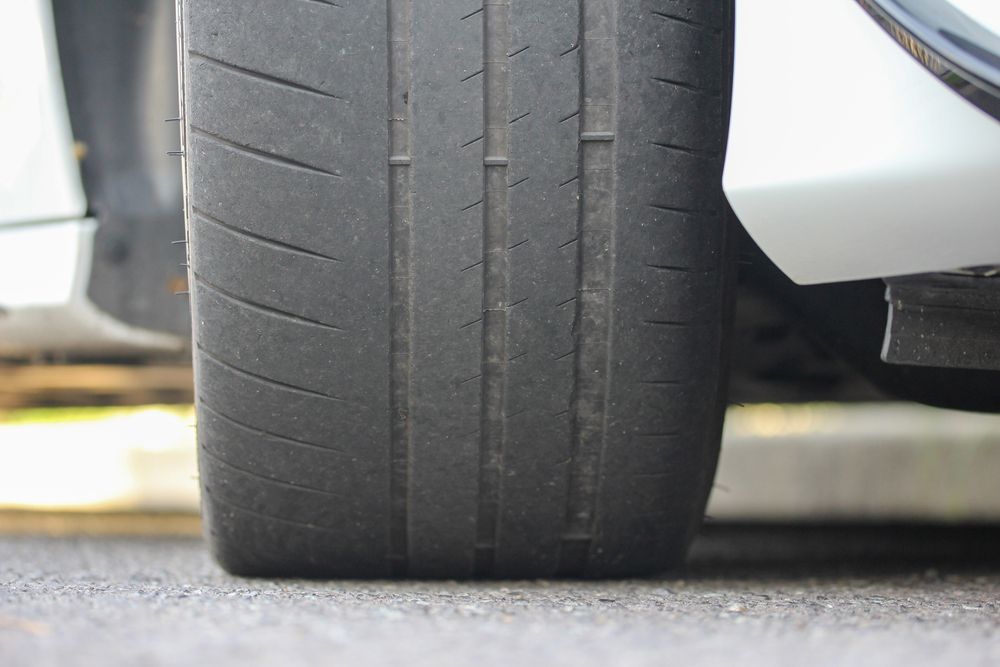 Worn tires
Worn tires
Do Cheap Tires Wear Faster?
Generally, cheap tires will wear quicker than premium models from well-known manufacturers.
The adage, "you get what you pay for," couldn't be more applicable in the tire-buying world.
Tips for Maintaining a Long Tire Life
To get the most bang for your buck, ensure your tires live a long life by:
- Maintain correct air pressure.
- Rotating your tires and balancing your wheels every 5,000 miles.
- Check your alignment twice a year.
- Cleaning the wheels and tires regularly.
Conclusion
New tires come with a tread depth of 10/32" or 11/32".
Regularly measuring the depth using a penny, the wear indicators, or a gauge ensures you never go below the legal limit of 2/32".
FAQ
Should I Replace My Tires at 3/32"?
Mechanics often suggest replacing tires once they hit 3/32", especially if you live in wetter, harsher climates.
Should I Replace Tires at 4/32"?
Most manufacturers urge you to replace your tires at 4/32 because they believe waiting until 2/32" presents too much risk.
Is 4/32nds of Tread Depth Legal?
According to U.S. law, 4/32" of tread depth is legal, and anything below 2/32 is not.
Is 5/32" a Good Tire Tread Depth?
A 5/32" tread depth is considered acceptable.
Should I Replace Tires 6/32"?
Per our tire tread depth chart, you don't need to replace them at this stage.
Is a Tire Tread Depth of 8/32" Good?
Your tires are in the optimal range if the gauge reads at least 8/32".
How Much Is 9/32" Tread?
A Tread of 9/32 is equal to 9.281 inches or 7.14 mm and is considered optimal.
How Many Miles Will 3 mm Tread Last?
While it depends on many variables, your tires should last another 10,000 to 20,000 miles before reaching the legal limit.